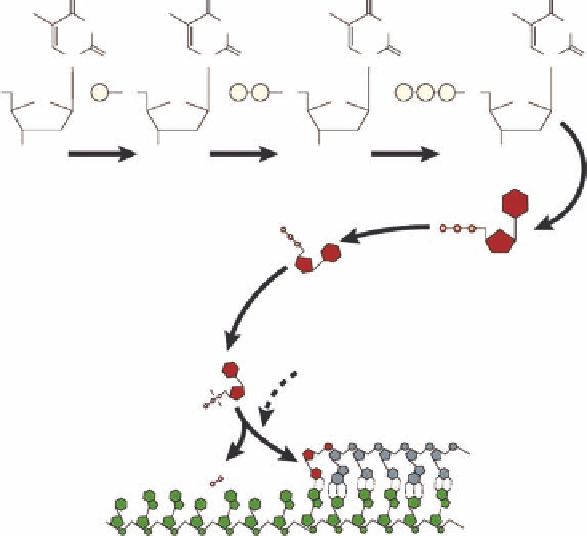Biomedical Engineering Reference
In-Depth Information
AZT
O
AZT-MP
AZT-DP
AZT-TP
O
O
O
NH
NH
NH
NH
N
O
N
O
N
O
N
O
HO
P
O
P
P
O
P
P
P
O
O
O
O
O
N
3
N
3
N
3
N
3
dThd kinase
dTMP kinase
NDP kinase
Reverse
transcriptase
DNA
RNA
FIGURE 24.2
Mechanism of action of azidothymidine (AZT). AZT needs to be phosphorylated, in three
steps, to the triphosphate form before it can interfere with the RT reaction. (After De Clercq, E.,
Nat. Rev.
Drug Discov
., 1, 13, 2002.)
24.2.1.3 Zalcitabine
Structure
(Figure 24.1): 2
-Dideoxycytidine (ddC), Hivid.
Activity spectrum
: HIV (types 1 and 2).
Mechanism of action
: Targeted at HIV RT, acts as chain terminator, following intracellular phos-
phorylation to ddC 5
′
,3
′
′
-triphosphate, and, after removal of the diphosphate group, incorporation of
ddC 5
-end of the viral DNA chain.
Principal indication(s)
: HIV infection, especially in adult patients with advanced HIV disease
that is intolerant or unresponsive to zidovudine, in combination with other anti-HIV agents (not
didanosine).
Administered
: Orally at 2.25 mg/day (one 0.75 mg tablet every 8 h).
′
-monophosphate at the 3
′
24.2.1.4 Stavudine
Structure
(Figure 24.1): 2
′
,3
′
-Didehydro-2
′
,3
′
-dideoxythymidine (d4T), Zerit
®
.
Activity spectrum
: HIV (types 1 and 2).
Mechanism of action
: Targeted at HIV RT, acts as chain terminator, following intracellular phos-
phorylation to d4T 5
′
-triphosphate, and, after removal of the diphosphate group, incorporation of
d4T 5
-end of the viral DNA chain.
Principal indication(s)
: HIV infection, especially advanced HIV disease, in combination with other
anti-HIV agents.
Administered
: Orally at 80 mg/day (one 40 mg capsule every 12 h).
′
-monophosphate at the 3
′

